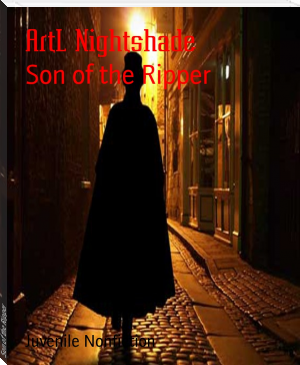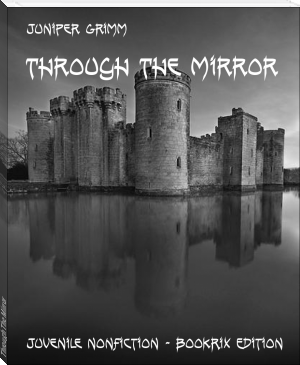Absolute Power, Ellen G. White [read the beginning after the end novel TXT] 📗

- Author: Ellen G. White
Book online «Absolute Power, Ellen G. White [read the beginning after the end novel TXT] 📗». Author Ellen G. White
With this reckoning, all was clear and harmonious, except that it was not seen that any event answering to the cleansing of the sanctuary had taken place in 1844. To deny that the days ended at that time was to involve the whole question in confusion, and to renounce positions which had been established by unmistakable fulfillments of prophecy. But God had led His people in the great advent movement; His power and glory had attended the work, and He would not permit it to end in darkness and disappointment, to be reproached as a false and fanatical excitement. He would not leave His word involved in doubt and uncertainty.
Though many abandoned their former reckoning of the prophetic periods and denied the correctness of the movement based thereon, others were unwilling to renounce points of faith and experience that were sustained by the Scriptures and by the witness of the Spirit of God. They believed that they had adopted sound principles of interpretation in their study of the prophecies, and that it was their duty to hold fast the truths already gained, and to continue the same course of Biblical research. With earnest prayer they reviewed their position and studied the Scriptures to discover their mistake. As they could see no error in their reckoning of the prophetic periods, they were led to examine more closely the subject of the sanctuary.
In their investigation they learned that there is no Scripture evidence sustaining the popular view that the earth is the sanctuary; but they found in the Bible a full explanation of the subject of the sanctuary, its nature, location, and services; the testimony of the sacred writers being so clear and ample as to place the matter beyond all question. The apostle Paul, in the Epistle to the Hebrews, says: "Then verily the first covenant had also ordinances of divine service, and a worldly sanctuary. For there was a tabernacle made; the first, wherein was the candlestick, and the table, and the shewbread; which is called the sanctuary. And after the second veil, the tabernacle which is called the holiest of all; which had the golden censer, and the ark of the covenant overlaid round about with gold, wherein was the golden pot that had manna, and Aaron's rod that budded, and the tables of the covenant; and over it the cherubims of glory shadowing the mercy seat." Hebrews 9:1-5.
The sanctuary to which Paul here refers was the tabernacle built by Moses at the command of God as the earthly dwelling place of the Most High. "Let them make Me a sanctuary; that I may dwell among them" (Exodus 25:8), was the direction given to Moses while in the mount with God. The Israelites were journeying through the wilderness, and the tabernacle was so constructed that it could be removed from place to place; yet it was a structure of great magnificence. Its walls consisted of upright boards heavily plated with gold and set in sockets of silver, while the roof was formed of a series of curtains, or coverings, the outer of skins, the innermost of fine linen beautifully wrought with figures of cherubim. Besides the outer court, which contained the altar of burnt offering, the tabernacle itself consisted of two apartments called the holy and the most holy place, separated by a rich and beautiful curtain, or veil; a similar veil closed the entrance to the first apartment.
In the holy place was the candlestick, on the south, with its seven lamps giving light to the sanctuary both by day and by night; on the north stood the table of shewbread; and before the veil separating the holy from the most holy was the golden altar of incense, from which the cloud of fragrance, with the prayers of Israel, was daily ascending before God. In the most holy place stood the ark, a chest of precious wood overlaid with gold, the depository of the two tables of stone upon which God had inscribed the law of Ten Commandments. Above the ark, and forming the cover to the sacred chest, was the mercy seat, a magnificent piece of workmanship, surmounted by two cherubim, one at each end, and all wrought of solid gold. In this apartment the divine presence was manifested in the cloud of glory between the cherubim.
After the settlement of the Hebrews in Canaan, the tabernacle was replaced by the temple of Solomon, which, though a permanent structure and upon a larger scale, observed the same proportions, and was similarly furnished. In this form the sanctuary existed--except while it lay in ruins in Daniel's time--until its destruction by the Romans, in A.D. 70. This is the only sanctuary that ever existed on the earth, of which the Bible gives any information. This was declared by Paul to be the sanctuary of the first covenant. But has the new covenant no sanctuary? Turning again to the book of Hebrews, the seekers for truth found that the existence of a second, or new-covenant sanctuary, was implied in the words of Paul already quoted: "Then verily the first covenant had also ordinances of divine service, and a worldly sanctuary." And the use of the word "also" intimates that Paul has before made mention of this sanctuary. Turning back to the beginning of the previous chapter, they read: "Now of the things which we have spoken this is the sum: We have such an High Priest, who is set on the right hand of the throne of the Majesty in the heavens; a Minister of the sanctuary, and of the true tabernacle, which the Lord pitched, and not man." Hebrews 8:1, 2.
Here is revealed the sanctuary of the new covenant. The sanctuary of the first covenant was pitched by man, built by Moses; this is pitched by the Lord, not by man. In that sanctuary the earthly priests performed their service; in this, Christ, our great High Priest, ministers at God's right hand. One sanctuary was on earth, the other is in heaven. Further, the tabernacle built by Moses was made after a pattern. The Lord directed him: "According to all that I show thee, after the pattern of the tabernacle, and the pattern of all the instruments thereof, even so shall ye make it." And again the charge was given, "Look that thou make them after their pattern, which was showed thee in the mount." Exodus 25:9, 40. And Paul says that the first tabernacle "was a figure for the time then present, in which were offered both gifts and sacrifices;" that its holy places were "patterns of things in the heavens;" that the priests who offered gifts according to the law served "unto the example and shadow of heavenly things," and that "Christ is not entered into the holy places made with hands, which are the figures of the true; but into heaven itself, now to appear in the presence of God for us." Hebrews 9:9, 23; 8:5; 9:24.
The sanctuary in heaven, in which Jesus ministers in our behalf, is the great original, of which the sanctuary built by Moses was a copy. God placed His Spirit upon the builders of the earthly sanctuary. The artistic skill displayed in its construction was a manifestation of divine wisdom. The walls had the appearance of massive gold, reflecting in every direction the light of the seven lamps of the golden candlestick. The table of shewbread and the altar of incense glittered like burnished gold. The gorgeous curtain which formed the ceiling, inwrought with figures of angels in blue and purple and scarlet, added to the beauty of the scene. And beyond the second veil was the holy Shekinah, the visible manifestation of God's glory, before which none but the high priest could enter and live.
The matchless splendour of the earthly tabernacle reflected to human vision the glories of that heavenly temple where Christ our forerunner ministers for us before the throne of God. The abiding place of the King of kings, where thousand thousands minister unto Him, and ten thousand times ten thousand stand before Him (Daniel 7:10); that temple, filled with the glory of the eternal throne, where seraphim, its shining guardians, veil their faces in adoration, could find, in the most magnificent structure ever reared by human hands, but a faint reflection of its vastness and glory. Yet important truths concerning the heavenly sanctuary and the great work there carried forward for man's redemption were taught by the earthly sanctuary and its services.
The holy places of the sanctuary in heaven are represented by the two apartments in the sanctuary on earth. As in vision the apostle John was granted a view of the temple of God in heaven, he beheld there "seven lamps of fire burning before the throne." Revelation 4:5. He saw an angel "having a golden censer; and there was given unto him much incense, that he should offer it with the prayers of all saints upon the golden altar which was before the throne." Revelation 8:3. Here the prophet was permitted to behold the first apartment of the sanctuary in heaven; and he saw there the "seven lamps of fire" and "the golden altar," represented by the golden candlestick and the altar of incense in the sanctuary on earth. Again, "the temple of God was opened" (Revelation 11:19), and he looked within the inner veil, upon the holy of holies. Here he beheld "the ark of His testament," represented by the sacred chest constructed by Moses to contain the law of God.
Thus those who were studying the subject found indisputable proof of the existence of a sanctuary in heaven. Moses made the earthly sanctuary after a pattern which was shown him. Paul teaches that that pattern was the true sanctuary which is in heaven. And John testifies that he saw it in heaven. In the temple in heaven, the dwelling place of God, His throne is established in righteousness and judgment. In the most holy place is His law, the great rule of right by which all mankind are tested. The ark that enshrines the tables of the law is covered with the mercy seat, before which Christ pleads His blood in the sinner's behalf. Thus is represented the union of justice and mercy in the plan of human redemption.
This union infinite wisdom alone could devise and infinite power accomplish; it is a union that fills all heaven with wonder and adoration. The cherubim of the earthly sanctuary, looking reverently down upon the mercy seat, represent the interest with which the heavenly host contemplate the work of redemption. This is the mystery of mercy into which angels desire to look--that God can be just while He justifies the repenting sinner and renews His intercourse with the fallen race; that Christ could stoop to raise unnumbered multitudes from the abyss of ruin and clothe them with the spotless garments of His own righteousness to unite with angels who have never fallen and to dwell forever in the presence of God.
The work of Christ as man's intercessor is presented in that beautiful prophecy of Zechariah concerning Him "whose name is the Branch." Says the prophet: "He shall build the temple of the Lord; and He shall bear the glory, and shall sit and rule upon His [the Father's] throne; and He shall be a priest upon His throne: and the counsel of peace shall be between Them both." Zechariah 6:12, 13. "He shall build the temple of the Lord." By His sacrifice and mediation Christ is both the foundation and the builder of the church of God. The apostle Paul points to Him as "the chief Cornerstone; in whom all the building fitly framed together groweth into an holy temple in the Lord: in whom ye also," he says, "are builded together for an habitation of God through the Spirit." Ephesians 2:20-22. "He shall bear the glory." To Christ belongs the glory of redemption for the fallen race. Through the eternal ages, the song of the ransomed ones will be: "Unto Him that loved us, and washed us from our sins in His own blood, . . .





Comments (0)